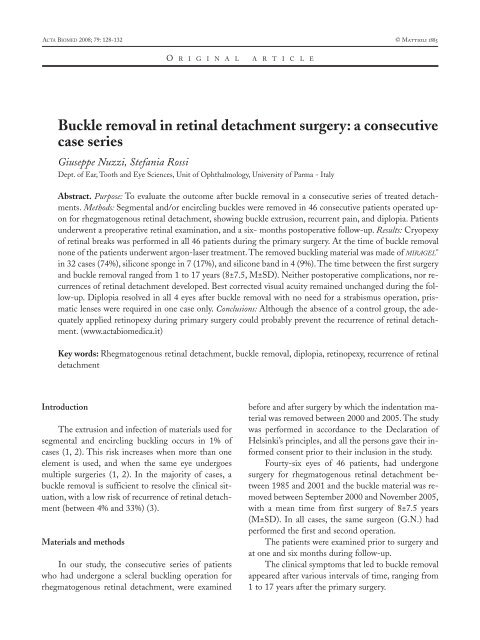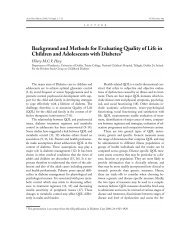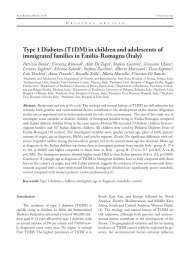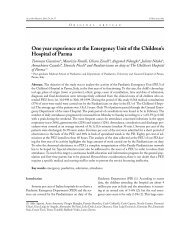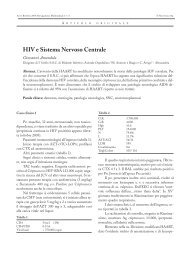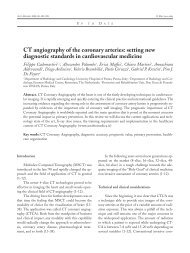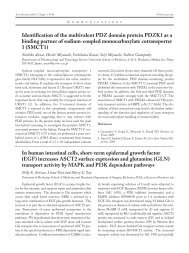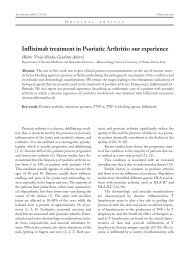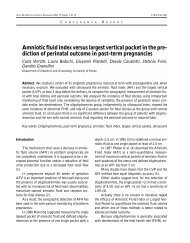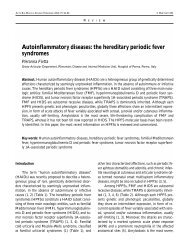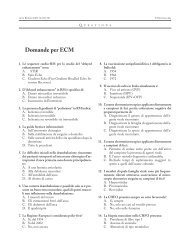Buckle removal in retinal detachment surgery - Acta Bio Medica ...
Buckle removal in retinal detachment surgery - Acta Bio Medica ...
Buckle removal in retinal detachment surgery - Acta Bio Medica ...
Create successful ePaper yourself
Turn your PDF publications into a flip-book with our unique Google optimized e-Paper software.
ACTA BIOMED 2008; 79: 128-132 © Mattioli 1885<br />
O R I G I N A L A R T I C L E<br />
<strong>Buckle</strong> <strong>removal</strong> <strong>in</strong> ret<strong>in</strong>al <strong>detachment</strong> <strong>surgery</strong>: a consecutive<br />
case series<br />
Giuseppe Nuzzi, Stefania Rossi<br />
Dept. of Ear, Tooth and Eye Sciences, Unit of Ophthalmology, University of Parma - Italy<br />
Abstract. Purpose: To evaluate the outcome after buckle <strong>removal</strong> <strong>in</strong> a consecutive series of treated <strong>detachment</strong>s.<br />
Methods: Segmental and/or encircl<strong>in</strong>g buckles were removed <strong>in</strong> 46 consecutive patients operated upon<br />
for rhegmatogenous ret<strong>in</strong>al <strong>detachment</strong>, show<strong>in</strong>g buckle extrusion, recurrent pa<strong>in</strong>, and diplopia. Patients<br />
underwent a preoperative ret<strong>in</strong>al exam<strong>in</strong>ation, and a six- months postoperative follow-up. Results: Cryopexy<br />
of ret<strong>in</strong>al breaks was performed <strong>in</strong> all 46 patients dur<strong>in</strong>g the primary <strong>surgery</strong>. At the time of buckle <strong>removal</strong><br />
none of the patients underwent argon-laser treatment. The removed buckl<strong>in</strong>g material was made of MIRAGEL ®<br />
<strong>in</strong> 32 cases (74%), silicone sponge <strong>in</strong> 7 (17%), and silicone band <strong>in</strong> 4 (9%). The time between the first <strong>surgery</strong><br />
and buckle <strong>removal</strong> ranged from 1 to 17 years (8±7.5, M±SD). Neither postoperative complications, nor recurrences<br />
of ret<strong>in</strong>al <strong>detachment</strong> developed. Best corrected visual acuity rema<strong>in</strong>ed unchanged dur<strong>in</strong>g the follow-up.<br />
Diplopia resolved <strong>in</strong> all 4 eyes after buckle <strong>removal</strong> with no need for a strabismus operation, prismatic<br />
lenses were required <strong>in</strong> one case only. Conclusions: Although the absence of a control group, the adequately<br />
applied ret<strong>in</strong>opexy dur<strong>in</strong>g primary <strong>surgery</strong> could probably prevent the recurrence of ret<strong>in</strong>al <strong>detachment</strong>.<br />
(www.actabiomedica.it)<br />
Key words: Rhegmatogenous ret<strong>in</strong>al <strong>detachment</strong>, buckle <strong>removal</strong>, diplopia, ret<strong>in</strong>opexy, recurrence of ret<strong>in</strong>al<br />
<strong>detachment</strong><br />
Introduction<br />
The extrusion and <strong>in</strong>fection of materials used for<br />
segmental and encircl<strong>in</strong>g buckl<strong>in</strong>g occurs <strong>in</strong> 1% of<br />
cases (1, 2). This risk <strong>in</strong>creases when more than one<br />
element is used, and when the same eye undergoes<br />
multiple surgeries (1, 2). In the majority of cases, a<br />
buckle <strong>removal</strong> is sufficient to resolve the cl<strong>in</strong>ical situation,<br />
with a low risk of recurrence of ret<strong>in</strong>al <strong>detachment</strong><br />
(between 4% and 33%) (3).<br />
Materials and methods<br />
In our study, the consecutive series of patients<br />
who had undergone a scleral buckl<strong>in</strong>g operation for<br />
rhegmatogenous ret<strong>in</strong>al <strong>detachment</strong>, were exam<strong>in</strong>ed<br />
before and after <strong>surgery</strong> by which the <strong>in</strong>dentation material<br />
was removed between 2000 and 2005. The study<br />
was performed <strong>in</strong> accordance to the Declaration of<br />
Hels<strong>in</strong>ki’s pr<strong>in</strong>ciples, and all the persons gave their <strong>in</strong>formed<br />
consent prior to their <strong>in</strong>clusion <strong>in</strong> the study.<br />
Fourty-six eyes of 46 patients, had undergone<br />
<strong>surgery</strong> for rhegmatogenous ret<strong>in</strong>al <strong>detachment</strong> between<br />
1985 and 2001 and the buckle material was removed<br />
between September 2000 and November 2005,<br />
with a mean time from first <strong>surgery</strong> of 8±7.5 years<br />
(M±SD). In all cases, the same surgeon (G.N.) had<br />
performed the first and second operation.<br />
The patients were exam<strong>in</strong>ed prior to <strong>surgery</strong> and<br />
at one and six months dur<strong>in</strong>g follow-up.<br />
The cl<strong>in</strong>ical symptoms that led to buckle <strong>removal</strong><br />
appeared after various <strong>in</strong>tervals of time, rang<strong>in</strong>g from<br />
1 to 17 years after the primary <strong>surgery</strong>.
<strong>Buckle</strong> <strong>removal</strong><br />
129<br />
Preoperatively and dur<strong>in</strong>g the follow-up, visual<br />
acuity (ETDRS) and <strong>in</strong>traocular pressure were determ<strong>in</strong>ed.<br />
In addition, <strong>in</strong> both eyes, extensive exam<strong>in</strong>ation<br />
of ocular motility, and of the anterior and posterior<br />
segment with dilation of pupil were performed.<br />
Preoperative draw<strong>in</strong>gs, <strong>in</strong>traoperative notes and<br />
cl<strong>in</strong>ical records from 1985 to 2001 provided details on:<br />
the type of ret<strong>in</strong>al <strong>detachment</strong>, surgical technique,<br />
buckl<strong>in</strong>g material and the <strong>in</strong>tra- and postoperative<br />
course.<br />
Results<br />
Three patients did not provide a complete follow-up:<br />
One patient moved to another city, the others<br />
preferred be<strong>in</strong>g referred to another specialist. Therefore,<br />
the study, the statistical analysis and the charts<br />
refer exclusively to the 43 eyes of the 43 patients with<br />
a complete follow-up.<br />
The age of the patients studied varied between 24<br />
and 76 years (58.7 ± 17.8 years; Mean ± DS), 25 patients<br />
were female, 18 male. Two patients had suffered<br />
from a post-traumatic ret<strong>in</strong>al <strong>detachment</strong> (severe bulbar<br />
contusion). The pre-surgical best corrected visual<br />
acuity <strong>in</strong> the operated eye ranged from count<strong>in</strong>g f<strong>in</strong>gers<br />
to 20/16.<br />
Among the patients studied 32 (74%) were phakic,<br />
9 (22%) pseudophakic and 2 (4%) aphakic, corrected<br />
with a corneal contact lens. Thirteen eyes (30%)<br />
had a myopia greater than 8 diopters with myopic<br />
chorioret<strong>in</strong>al atrophy. In all eyes treated ret<strong>in</strong>opexy<br />
presented a sufficient scar around the breaks, the ret<strong>in</strong>a<br />
was attached <strong>in</strong> all four quadrants and at the posterior<br />
pole prior to <strong>removal</strong> of the buckle material.<br />
As far as the contralateral eye was concerned, visual<br />
acuity ranged from 20/200 to 20/16; <strong>in</strong> 9 eyes a<br />
myopia greater than 8 diopters with myopic chorioret<strong>in</strong>al<br />
atrophy was present, <strong>in</strong> one eye with an additional<br />
area of untreated lattice degeneration. Two patients<br />
had suffered ret<strong>in</strong>al <strong>detachment</strong> <strong>in</strong> both eyes. The former<br />
had undergone scleral buckl<strong>in</strong>g with cryopexy <strong>in</strong><br />
the right eye and one year later segmental buckl<strong>in</strong>g,<br />
encircl<strong>in</strong>g and cryopexy <strong>in</strong> the left eye. This patient<br />
had undergone segmental buckle <strong>removal</strong> <strong>in</strong> his left eye<br />
four years prior to our study. However, the cutt<strong>in</strong>g of<br />
the encircl<strong>in</strong>g band without its <strong>removal</strong> <strong>in</strong> the same eye<br />
belongs to the cases exam<strong>in</strong>ed <strong>in</strong> our study. In this case,<br />
the culture for bacteria taken from the necrosis beneath<br />
the encircl<strong>in</strong>g band, revealed Streptococcus pneumoniae.<br />
The second patient, who was aphakic, had been<br />
treated with a segmental buckle and cryopexy <strong>in</strong> both<br />
eyes. Subsequently the buckle had to be removed from<br />
the eye which was operated on first.<br />
The f<strong>in</strong>d<strong>in</strong>gs lead<strong>in</strong>g to buckle <strong>removal</strong> were<br />
(Fig. 1):<br />
- a pa<strong>in</strong>ful eye <strong>in</strong> 30 of the 43 eyes (70%),<br />
- buckle extrusion <strong>in</strong> 17 eyes (40%),<br />
- persistent conjunctivitis <strong>in</strong> 6 eyes (13%),<br />
- diplopia <strong>in</strong> 4 eyes (9%),<br />
- decrease of visual acuity <strong>in</strong> 1 eye (2 %). In this<br />
case, however, the symptoms the patient compla<strong>in</strong>ed<br />
of were due to the need of a new refraction,<br />
at which a partial extrusion of the buckle<br />
was detected.<br />
In all patients, the symptoms disappeared a few<br />
days after buckle <strong>removal</strong>.<br />
The buckles removed were made of:<br />
- MIRAGEL ® <strong>in</strong> 32 eyes (74 %)<br />
- silicon sponge <strong>in</strong> 7 eyes (17 %)<br />
- silicon band <strong>in</strong> 4 eyes (9 %)<br />
In 6 eyes (19%), all with MIRAGEL ® buckles, the<br />
<strong>removal</strong> was <strong>in</strong>complete, due to technical difficulties<br />
and the tendency of the buckle material to fragment.<br />
Three of these patients underwent a reoperation, that<br />
succeeded <strong>in</strong> remov<strong>in</strong>g all of the MIRAGEL ® buckle material.<br />
In our study no <strong>in</strong>traoperative nor postoperative<br />
complications occurred, and no patient developed a<br />
recurrence of ret<strong>in</strong>al <strong>detachment</strong> dur<strong>in</strong>g the followup.<br />
The <strong>in</strong>terval between primary <strong>surgery</strong> and buckle<br />
<strong>removal</strong> varied from 1 to 17 years, with an average<br />
of 8±7.5 years (Mean±SD) (Fig. 2). In particular, it<br />
was between 1 and 3 years for silicon sponge buckles,<br />
between 5 and 14 years for Miragel®, and between 10<br />
and 17 years for silicon bands.<br />
Visual acuity rema<strong>in</strong>ed unchanged at 1 month<br />
and 6 month follow-up. At the end of follow-up, <strong>in</strong><br />
the 43 eyes the ret<strong>in</strong>a had rema<strong>in</strong>ed attached without<br />
any need for prophylaxis such as cryopexy or argon<br />
laser treatment.
130 G. Nuzzi, S. Rossi<br />
Figure 1. Ocular symptoms lead<strong>in</strong>g to buckle <strong>removal</strong> <strong>in</strong> relation to buckle material<br />
Figure 1. Interval between primary <strong>surgery</strong> and buckle <strong>removal</strong>
<strong>Buckle</strong> <strong>removal</strong><br />
131<br />
Discussion<br />
<strong>Buckle</strong> extrusion, MIRAGEL ® <strong>in</strong> particular, is widely<br />
reported <strong>in</strong> literature. In one publication the mean<br />
latency reported ranged at 8.3 years, vary<strong>in</strong>g between<br />
6 months and 14 years [6]. The high risk of extrusion<br />
of MIRAGEL ® buckles has been correlated to the great<br />
tendency of the material to hydrate, comb<strong>in</strong>ed with alterations<br />
of its microscopic structure (4), progressive<br />
<strong>in</strong>crease of volume, subsequent fragmentation and loss<br />
of <strong>in</strong>dentation effect.<br />
Of the 43 patients <strong>in</strong> the study, 32 (74%) eyes had<br />
MIRAGEL ® material, 7 (17%) had silicone sponge buckles<br />
and 4 (9%) silicone bands. In 8 eyes (19%), the segmental<br />
buckle and ret<strong>in</strong>opexy were comb<strong>in</strong>ed with an<br />
encircl<strong>in</strong>g band. Only one of these was removed, due<br />
to evidence of necrosis.<br />
The f<strong>in</strong>d<strong>in</strong>gs which led to the <strong>in</strong>dication of buckle<br />
<strong>removal</strong> are <strong>in</strong> agreement with what is described <strong>in</strong><br />
the literature, that means eye discomfort or ocular<br />
pa<strong>in</strong>, comb<strong>in</strong>ed with extrusion of the buckle, persistent<br />
conjunctivitis, diplopia and decrease of visual acuity<br />
(5). Unlike other studies, we did not observe any<br />
significant difference <strong>in</strong> the symptoms <strong>in</strong> relation to<br />
the buckle materials applied (6). Diplopia resolved <strong>in</strong><br />
all eyes after buckle <strong>removal</strong>, with no need for subsequent<br />
strabismus operation. Only one eye required<br />
prisms for correction.<br />
The time elaps<strong>in</strong>g between buckle implant<strong>in</strong>g<br />
and its <strong>removal</strong> varied from 1 to 17 years <strong>in</strong> our<br />
study, with the longest latency for the silicon bands,<br />
and the shortest for silicone sponge. Past studies<br />
confirm the shorter duration of silicone sponge, but<br />
identified MIRAGEL ® as the material with the longest<br />
last<strong>in</strong>g <strong>in</strong>dentation (6, 7). Except for one eye, it was<br />
not necessary to remove the encircl<strong>in</strong>g buckle comb<strong>in</strong>ed<br />
with the scleral buckle, when present, because<br />
it was well tolerated and there were no signs of scleral<br />
erosion.<br />
In our study, none of the patients underwent laser<br />
“prophylactic” treatment prior to buckle <strong>removal</strong> and<br />
no re<strong>detachment</strong> was observed. The operative notes<br />
show that <strong>in</strong> all eyes <strong>in</strong>traoperative cryopexy was rout<strong>in</strong>ely<br />
performed at the primary <strong>surgery</strong>. It’s not possible,<br />
anyway, to determ<strong>in</strong>e whether, <strong>in</strong> the absence of<br />
this treatment, recurrences would have occurred. In<br />
our op<strong>in</strong>ion ret<strong>in</strong>opexy at the time of the primary<br />
<strong>surgery</strong> (<strong>in</strong>traoperative cryopexy) exactly placed<br />
around the break and of correct dosage could safeguard<br />
from recurrence of a ret<strong>in</strong>al <strong>detachment</strong>, if it<br />
should necessary to remove the buckle material. The<br />
Ret<strong>in</strong>opexy scars provide a sufficient protection<br />
aga<strong>in</strong>st vitreo-ret<strong>in</strong>al tractions on the break when the<br />
buckl<strong>in</strong>g effect starts to decrease. This is also the case<br />
of MIRAGEL ® buckles, that hydrolyse after a few years<br />
with a result<strong>in</strong>g decrease of the <strong>in</strong>dentation effect (4).<br />
A well performed cryopexy, i.e. under ophthalmoscopic<br />
control and with m<strong>in</strong>imal whiten<strong>in</strong>g of the ret<strong>in</strong>a,<br />
would not <strong>in</strong>crease the risk of postoperative vitreous<br />
proliferation (8), and provides an excellent protection<br />
aga<strong>in</strong>st re<strong>detachment</strong>. At our knowledge, it has not<br />
yet been demonstrated that <strong>in</strong>dentation alone can <strong>in</strong>duce<br />
a ret<strong>in</strong>opexic scar comparable to that caused by<br />
cryopexy or laser treatment. Moreover, at our knowledge,<br />
the literature does not <strong>in</strong>dicate a safe time for<br />
buckle <strong>removal</strong> <strong>in</strong> ret<strong>in</strong>al <strong>detachment</strong> <strong>surgery</strong>. The<br />
procedure appeared to be a somehow not risky for the<br />
eye, comb<strong>in</strong>ed with a great chance that the symptoms<br />
will be resolved.<br />
Acknowledgements<br />
We thank Prof. Ingrid Kreissig (Mannheim, Germany)<br />
for her k<strong>in</strong>d assistance dur<strong>in</strong>g the paper revision<br />
and for her precious suggestions.<br />
References<br />
1. L<strong>in</strong>coff H. Pre-operative antibiotic soak<strong>in</strong>g of silicone sponges:<br />
Does it make a difference Ophthalmology 1984; 91:<br />
1689.<br />
2. Wiznia RA. Removal of solid silicon rubber explants after<br />
ret<strong>in</strong>al <strong>detachment</strong> <strong>surgery</strong>. Am J Ophthalmol 1983; 95: 495.<br />
3. L<strong>in</strong>dsey PS, Pierce LH. Removal of scleral buckl<strong>in</strong>g elements:<br />
Causes and complications. Arch Ophthalmol 1983;<br />
101: 570.<br />
4. Oshitari K, Hida T, Okada AA. Long term complications of<br />
hydrogel buckles. Ret<strong>in</strong>a 2003; 23: 257-61.<br />
5. Deokule S, Reg<strong>in</strong>ald A. Scleral explant <strong>removal</strong>: the last decade.<br />
Eye 2003;17: 697-700.<br />
6. Le Rouic JF, Bettembourg O. Late swell<strong>in</strong>g and <strong>removal</strong> of<br />
hydrogel buckles: a comparison with silicone <strong>in</strong>dentations.<br />
Ret<strong>in</strong>a 2003; 23: 641-6.
132 G. Nuzzi, S. Rossi<br />
7. Roldan-Pallares M, del Castillo Sanz JL, Awad-El Susi S,<br />
Refojo MF. Long-term complications of silicone and hydrogel<br />
explants <strong>in</strong> ret<strong>in</strong>al reattachment <strong>surgery</strong>. Arch Ophthalmol<br />
1999; 117 (10): 1449.<br />
8. Avitabile T, Bartolotta G, Torrisi B, Reibaldi A. A randomized<br />
prospective study of rhegmatogenous ret<strong>in</strong>al <strong>detachment</strong><br />
cases treated with cryopexy versus frequency-doubled<br />
Nd:YAG laser-ret<strong>in</strong>opexy dur<strong>in</strong>g episcleral <strong>surgery</strong>. Ret<strong>in</strong>a<br />
2004; 24 (6): 878-82.<br />
Accepted: 7 July 2008<br />
Correspondence: Giuseppe Nuzzi, MD<br />
Associate Professor of Ophthalmology<br />
Dept. of Ear, Tooth and Eye Sciences - Unit of Ophthalmology<br />
University of Parma<br />
Via Gramsci 14 – 43100 Parma (Italy)<br />
Tel. ++39 0521 70 31 06<br />
Fax ++39 0521 98 30 27<br />
E-mail: nuzzi@unipr.it; www.actabiomedica.it


